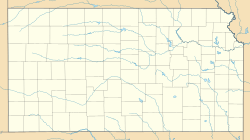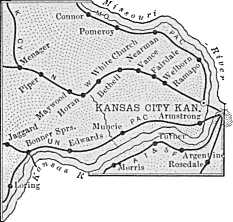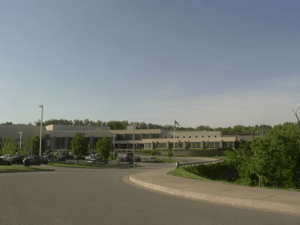Turner, Kansas facts for kids
Quick facts for kids
Turner, Kansas
|
|
|---|---|
|
Neighborhood
|
|
| Country | United States |
| State | Kansas |
| County | Wyandotte |
| Elevation | 830 ft (253 m) |
| Time zone | UTC-6 (CST) |
| • Summer (DST) | UTC-5 (CDT) |
| Area code | 913 |
| FIPS code | 20-71775 |
| GNIS feature ID | 0478951 |
Turner is a neighborhood located in Kansas City, Kansas. It used to be a separate community in Wyandotte County. Today, Turner has its own school district, called Turner USD #202.
Contents
Exploring Turner's Past
Long ago, a Native American leader named The Prophet (whose name means "the door opener") created a place called Shawneetown here. This was near where Woodend and Shawnee Drive are today. He later lived near Turner in Argentine, Kansas. Blue Jacket, who was like a brother to Tecumseh, was also known in this area. Legend says that a Shawnee chief named Fish was buried in the Shawnee Township Cemetery, which is in the middle of modern-day Turner.
Early Days in the 19th Century
In 1828, Cyprian Chouteau set up the first trading post in this area. It was a place where people could trade goods, located near 55th and Speaker Road. The first Shawnee Methodist Mission was built in 1830 near this trading post. Reverend Thomas Johnson built this mission for the Shawnee people. It was located at what is now the 5100 block of Edgehill Drive. This mission was open until 1839.
Around 1837, Charles Lovelace built a saw mill nearby. There was also a grist mill for grinding grain. In 1838, a large steamboat called "The Antelope" stopped here. It carried scientists and pioneers heading west to Fort Pierre, South Dakota.
The Grinter Ferry
The Delaware Crossing was a spot where an old Native American trail met the Kaw River. Around 1831, Moses Grinter, one of the first white settlers, started the Grinter Ferry across the Kansas River. His house, the Grinter Place, still stands today at 1420 South 78th Street. The ferry helped traders, freighters, and soldiers travel between Fort Leavenworth and Fort Scott. Others used it on their way to Santa Fe.
By the fall of 1854, many farmers had settled around Turner. The community was known as "Farmer, Kansas" as early as 1856. In 1859, they tried to become an official town, but they didn't have enough people.
In July 1863, a group called Quantrill's Raiders attacked some homes in the area. Families living between Swartz Road and 51st to 53rd Street were affected. Some homes managed to defend themselves.
The community's first post office was set up in 1859 and was called "Farmer." Twenty years later, on September 23, 1879, the post office name was changed to "Turner" by Robert M. Hester.
Turner in the 20th Century
The Flood of 1903 caused damage in Turner. By 1910, about 200 people lived there. In 1912, Turner had general stores, a school, a post office, and telegraph services.
The Atchison, Topeka and Santa Fe Railway used to run through Argentine, Turner, and Kaw Valley. Trains would turn around at the Farmer train platform, which was at 55th Street, the main downtown area of Turner.
Parts of Turner were hit by the Great Flood of 1951. After this flood, the "Highland" community was built for people who lost their homes. Between 1965 and 1966, Kansas City, Kansas, officially took over the community of Turner. Even though it's now part of Kansas City, Turner still has its own unique feel.
The Turner post office closed in 1958.
Learning in Turner
Schools and Education
The community is served by the Turner USD 202 public school district.
The Golden Bear became the school's mascot in 1886. Two community members, Warren Hewitt and Jule Gaignet, suggested the idea, and it won a contest. They had heard stories about a golden bear from their grandparents. This mascot is based on legends of a golden bear that lived in the area.
According to John Gardiner in 1831, a large golden bear lived in the hills west of the Methodist Mission. It was feared and admired by the local Native Americans. Legend says it was the biggest bear anyone had ever seen. It would raid settlements and eat animals owned by the Shawnee tribe. Many Native Americans wanted to hunt the bear for its valuable fur. The golden bear was seen several times by the ferry crew on the Old Grinter Ferry in the 1830s and 1840s. Both the Shawnee and Wyandot tribes tried to hunt it, but they never found it.
In 1961, Turner USD 202 combined five old school districts: Turner, Junction, Oak Grove, Morris, and Muncie. Today, the district includes:
- Turner High School
- Turner Middle School
- Turner Primary
- Junction Primary
- Oak Grove Primary
- Midland Trail Primary
- Sixth Grade Academy
Getting Around Turner
Major Roads
- Interstate 435
- Turner Diagonal
- K-132
Street Names and Their Stories
The people in charge of the roads were Peter Partonnar, John Gibbs, and H. L. Swinggley. Some people thought Peter Partonnar's name might be where "Turner" came from, but this is probably not true. The Partonnar family lived in Shawnee for many years before moving to Turner, and the name "Turner" was already used.
- New and old street names
- 55th Street (part of it) was once called "Lovelace Mill Road." Later, it was named "Ambrose Key Road" after the saw mill closed. Before Turner became part of Kansas City, it was called "Turner Avenue." (55th Street leads to Douglas and then to Key Lane, which goes to Gibbs Road.)
- 56th Street was known as "Central Avenue."
- 57th Street was called "Ore Avenue."
- Gibbs Road was named after John Gibbs Jr.
- Metropolitan Avenue was "Hester Road." Albert Hester had a farm, Hester Farm, along this route. It also crossed the road from Fort Scott and Fort Leavenworth.
- Swartz Road was "Silver Avenue."
- Miami was "Smelter Avenue."
- Osage was "Cable Avenue."
- Key Lane was called "Ridgeview Road" for a while.




